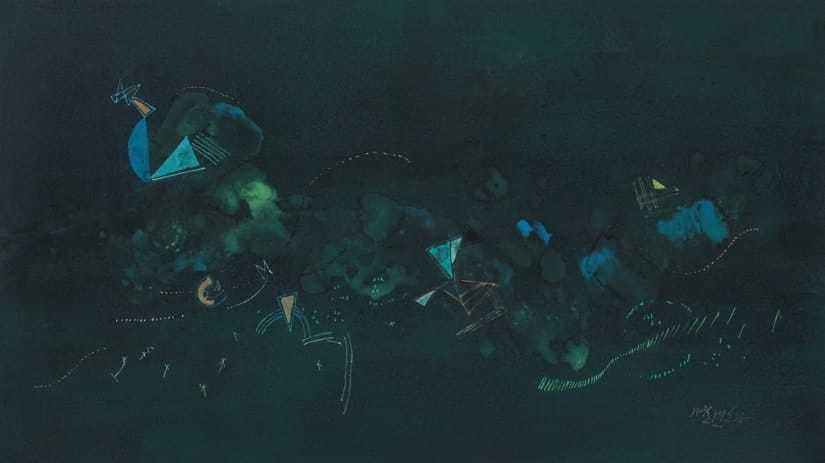“You cannot imagine how much freedom I enjoy. And because I feel that sense of infinite freedom, I can create my own land. It is my own world – parallel to and different from what you call reality." These are the words that greet me as I wander around the Akar Prakar Gallery in Kolkata, taking in “Form and Play” — a solo exhibition by Ganesh Haloi, and a showcase of the veteran artist’s most recent works. The medium is gouache on Nepali handmade paper. Paintings interspersed with text (his own words) stenciled onto the walls — in some instances peppered with a series of symbols and strokes; dashes and dots mirroring the ones in the paintings, almost as if they had escaped the confinement of the frame and spilled onto the wall. [caption id=“attachment_6010051” align=“alignnone” width=“825”]
 All works by Ganesh Haloi. Nepali handmade paper. Images courtesy Akar Prakar[/caption]
All works by Ganesh Haloi. Nepali handmade paper. Images courtesy Akar Prakar[/caption]
Ganesh Haloi's new exhibition, Form and Play, offers a pathway into the self-contained world of his art
Diya Katyal
• February 2, 2019, 09:46:45 IST
The overall effect of the exhibition of Ganesh Haloi’s works is to make us view the world afresh through the eyes of an artist who refuses to age.
Advertisement
)
I let the words wash over me as I study his work and I come to agree with them. Haloi’s paintings are a world unto themselves. Self-contained, geometrical and balanced, with none of the messiness that comes with reality. Yet there are familiar components, like elements from nature that are clearly discernible. It’s like they are communicating in a secret code, never revealing themselves fully to the viewer. Speaking with the gallerist Reena Lath of Akar Prakar, the gallery that represents Haloi, I asked her how she has seen his work evolve over the years.
“We have been engaging with Ganesh Haloi’s works for almost two decades — first as collectors, and later as his gallery. He has amazed us with the way his work has been evolving over the years. He surprises us with each body of work that he produces. Each time it’s fresher than the last. Remarkable for his age, when artists in his age group settle down with repetitive works, he is still able to bring newness to his work,” Lath says. Form and Play: A new exhibition highlights how Ganesh Haloi’s paintings oscillate between the seen and the sensed
Referring to certain themes that have remained a constant feature of Haloi’s work through the years, Lath adds: “His vision is what has been steady. When I speak of vision it is not what one sees with the eyes but it’s what he sees through his imagination. It’s the dialogue that emerges between him and his work that we experience as an energy field or the soul of the work. It emanates energy, a silence which is a unique quality of his work. Ganesh da is a very sensitive person and I have seen him withdraw into himself every couple of months, only to emerge stronger with a new body of work, which expresses itself as a release of sorts. This show too is one such release of an artistic and creative struggle and experience.”
Moving into a darkened room at the back, I view a video of the artist in conversation with Adam Szymezyk, talking about his medium and background, and it gives us a little insight into his creative process. Haloi talks about how he is deeply influenced by Indian miniatures and folk art. Watching miniaturists at work he noticed that the paper they were using was Nepali paper which was readily available in Kolkata in those days, “and I decided to use it because I use opaque colour which grips the paper, unlike transparent colour which is like a stain”. He talked about how when he returned to Kolkata after a stint in Ajanta, the kind of contemporary art on display at the time was largely figurative, with few abstractions. [In 1957, he was appointed by the Archaeological Survey of India to make copies of Ajanta murals. Seven years later, Haloi returned to Kolkata.] In yet another video interview he talks about how separation or any form of departure is linked with pain — a major theme of his work at one point in time.
Of what makes Ganesh Haloi’s style so unique, Reena Lath says, “All artists make or create their own language through their art, their own style; however, the topic or the expression in each body of work is different. It’s like a writer or poet who has created a particular style of writing, yet each story, or poem is different each time. Yes, there are certain motifs and symbols, lines and dashes which appear each time in his paintings, also a texture that emerges, but I cannot say they are constant. In fact they are constantly evolving. “ The playful relationship in nature between form, balance, rhythm and colour is what seems to define this body of work, executed with an elegant and light ease of touch that makes the paintings a pleasure to view. Hints and clues gesture to a world of graceful natural forms without explicitly spelling out the reference. Greens and blues predominate, and the overall effect is to make us view the world of nature afresh through the eyes of an artist who refuses to age. At Akar Prakar, P 238 Hindustan Park, Kolkata, until 11 February
End of Article